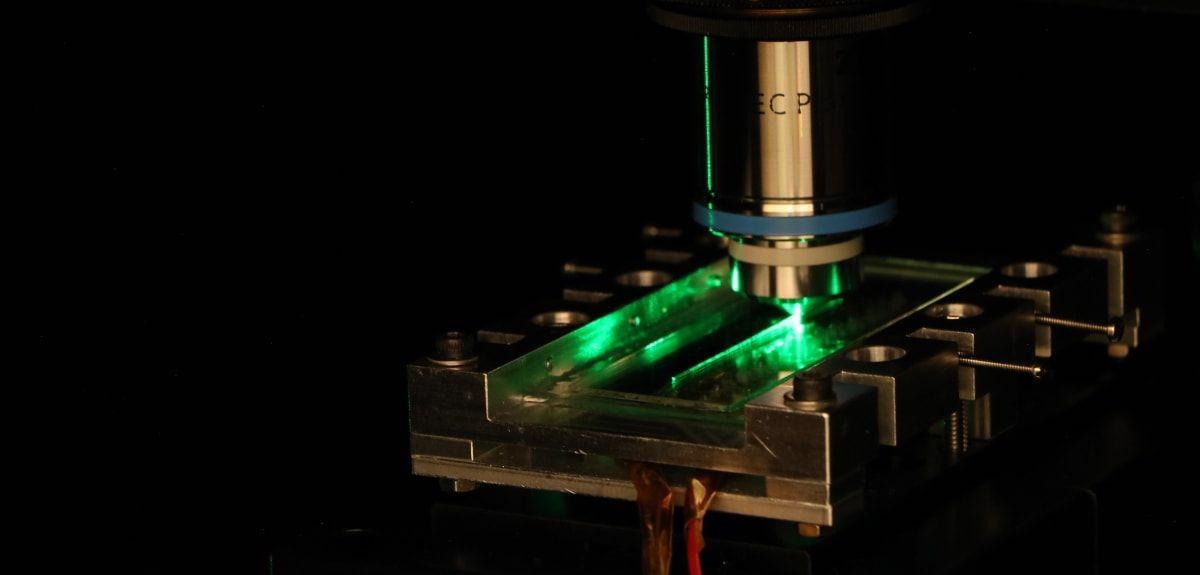Reviewed by Alex SmithApr 22 2022
Researchers at Oxford University have invented a sapphire fiber sensor that can withstand severe temperatures, with the potential to increase aerospace and power generating efficiency and significantly reduce emissions.
 Sapphire optical fiber. Image Credit: Julian Fells/University of Oxford.
Sapphire optical fiber. Image Credit: Julian Fells/University of Oxford.
The researchers used a sapphire optical fiber — a thread of industrially manufactured sapphire less than half a millimeter thick that can survive temperatures of over 2000 °C — in their research, which was published in the journal Optics Express.
Some light is reflected from a spot along with the sapphire fiber that has been modified to be temperature-sensitive when light is pumped onto one end (known as a Bragg grating). The temperature at that point is measured by the wavelength (color) of the reflected light.
The innovation tackles a 20-year-old problem with current sensors in which the sapphire fiber seems to be very thin but is quite large in contrast to the wavelength of light. This implies that light may travel in a variety of pathways through the sapphire fiber, resulting in many wavelengths being reflected at the same time.
The researchers solved this challenge by creating a channel down the length of the fiber, containing the light inside a one-hundredth of a millimeter-wide cross-section. Scientists were able to create a sensor that reflected mostly a single wavelength of light using this method.
The first demonstration used a one-centimeter-long sapphire fiber, but the researchers believe that lengths of up to several meters will be conceivable, with several sensors spaced along the length. This would, for example, allow temperature data to be taken throughout a jet engine.
Using this information to adjust engine conditions in flight has the potential to cut nitrogen oxide emissions and increase overall efficiency, lowering environmental impact. The sapphire’s radiation resistance makes it useful in the space and fusion power sectors.
The sensors are fabricated using a high-power laser with extremely short pulses and a significant hurdle was preventing the sapphire from cracking during this process.
Dr. Mohan Wang, Research Team Member, Department of Engineering Science, University of Oxford
The research was carried out in collaboration with Rolls-Royce, the UK Atomic Energy Authority (Remote Applications in Challenging Environments–RACE), Cranfield University, Halliburton, and MDA Space and Robotics as part of a £1.2 million EPSRC Fellowship Grant held by Dr. Julian Fells at the University of Oxford’s Department of Engineering Science.
This is exciting news and yet another important scientific achievement resulting from our long-standing partnership with Oxford University. This fundamental research could in time enable more efficient and accurate multi-point temperature measurement in harsh environments, improving control, efficiency, and safety. We look forward to working with the University of Oxford to explore its potential.
Mark Jefferies, Chief, University Research Liaison, Rolls-Royce plc
Rob Skilton, Head of the Research at RACE, UK Atomic Energy Authority added, “These sapphire optical fibers will have many different potential applications within the extreme environments of a fusion energy power plant. This technology has the potential to significantly increase the capabilities of future sensor and robotic maintenance systems in this sector, helping UKAEA in its mission to deliver safe, sustainable, low carbon fusion power to the grid.”
“We are very grateful to the UK Engineering and Physical Sciences Research Council (EPSRC) for supporting this work and to the reviewers who saw the potential for the challenging work we proposed. We are now working with our partners to further develop the technology to the point where it can be integrated into suitable infrastructure,” Dr. Fells, who lead the research work concluded.
Journal Reference:
Wang, Mohan., et al. (2022) Single-mode sapphire fiber Bragg grating. Optics Express. doi.org/10.1364/OE.446664.